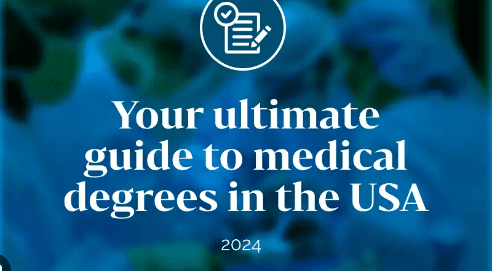Here’s an ultimate guide to medical degrees in the USA for 2024: Medical Degrees in the USA: Ultimate Guide (2024) Overview Medical degrees in the USA are designed to prepare students for careers in various fields of healthcare, from clinical practice to research and administration. This guide covers the types of medical degrees, the educational pathways, admission requirements, and career prospects. Types of Medical Degrees 1. Doctor of Medicine (MD) Focus: Traditional allopathic medicine, focusing on diagnosing and treating diseases using conventional methods. Duration: 4 years of medical school, followed by 3-7 years of residency training depending on the specialty. 2. Doctor of Osteopathic Medicine (DO) Focus: Holistic approach to medicine, emphasizing preventive care and the musculoskeletal system. Duration: Similar to MD, 4 years of medical school and 3-7 years of residency training. 3. Doctor of Dental Medicine (DMD) / Doctor of Dental Surgery (DDS) Focus: Oral health, including the diagnosis, prevention, and treatment of oral diseases.
Duration: 4 years of dental school, with optional residency for specialization. 4. Doctor of Pharmacy (PharmD) Focus: Pharmacology and patient care, preparing graduates for careers as pharmacists. Duration: 4 years of pharmacy school after completing pre-pharmacy requirements. 5. Doctor of Veterinary Medicine (DVM) Focus: Animal health, diagnosing and treating illnesses in animals. Duration: 4 years of veterinary school. 6. Doctor of Physical Therapy (DPT) Focus: Rehabilitation and physical therapy to improve patient mobility and quality of life. Duration: 3 years of physical therapy school after completing a bachelor’s degree. 7. Doctor of Nursing Practice (DNP) Focus: Advanced practice nursing, including clinical practice, leadership, and policy. Duration:
3-4 years, depending on the program and prior nursing experience. Educational Pathways Undergraduate Education Pre-Med Requirements: Students typically complete a bachelor’s degree with courses in biology, chemistry, physics, and math. Common Majors: Biology, Chemistry, Biochemistry, Neuroscience. Medical College Admission Test (MCAT) Purpose: Standardized test required for MD and DO programs. Content: Biological and biochemical foundations of living systems, chemical and physical foundations of biological systems, psychological, social, and biological foundations of behavior, and critical analysis and reasoning skills. Medical School Curriculum: First two years focus on basic sciences (anatomy, physiology, pathology),
while the last two years involve clinical rotations in various specialties. Clinical Rotations: Include internal medicine, surgery, pediatrics, psychiatry, and more. Residency Training Specialization: After medical school, graduates enter residency programs in their chosen specialty. Duration: 3-7 years depending on the specialty (e.g., family medicine, surgery, neurology). Admission Requirements Bachelor’s Degree Completion of a bachelor’s degree with required pre-med courses. MCAT Scores Competitive scores are crucial for admission into top programs. GPA Strong academic performance, typically a GPA of 3.5 or higher. Clinical Experience Volunteer work, internships, or employment in healthcare settings. Research Experience Participation in research projects can strengthen applications. Letters of Recommendation Strong recommendations from
professors, employers, or healthcare professionals. Personal Statement Explanation of motivations for pursuing a medical career and relevant experiences. Career Prospects Physicians and Surgeons (MD, DO) Median Salary (2024): $250,000 – $400,000, varying by specialty. Job Outlook (2024-2034): Expected growth of 4%, with higher demand in underserved areas. Dentists (DMD, DDS) Median Salary (2024): $175,000. Job Outlook (2024-2034): Expected growth of 8%. Pharmacists (PharmD) Median Salary (2024): $130,000. Job Outlook (2024-2034): Expected growth of 2%. Veterinarians (DVM) Median Salary (2024): $110,000. Job Outlook (2024-2034): Expected growth of 16%. Physical Therapists (DPT) Median Salary (2024): $95,000. Job
Outlook (2024-2034): Expected growth of 21%. Nurse Practitioners (DNP) Median Salary (2024): $120,000. Job Outlook (2024-2034): Expected growth of 28%. Conclusion Pursuing a medical degree in the USA is a challenging but rewarding path. It requires dedication, rigorous education, and a passion for healthcare. The career prospects are promising, with various specialties offering excellent salaries and job growth potential. Whether your interest lies in human medicine, dentistry, pharmacy, veterinary medicine, physical therapy, or advanced nursing, there is a medical degree that can help you achieve your career goals.
Doctor of Medicine (MD) Degrees in the USA (2024)
A Doctor of Medicine (MD) degree is a professional graduate degree awarded to physicians and surgeons. In the United States, obtaining an MD involves rigorous academic and clinical training designed to prepare students for a variety of careers in medicine. Educational Pathway 1. Undergraduate Education Duration: 4 years. Pre-Med Requirements: Courses in biology, chemistry (general and organic), physics, and mathematics. Common Majors: Biology, Chemistry, Biochemistry, Neuroscience, or any major with the requisite science courses. 2. Medical College Admission Test (MCAT) Purpose: Standardized test required for admission to MD programs. Content: Biological and Biochemical Foundations of Living Systems. Chemical and Physical
Foundations of Biological Systems. Psychological, Social, and Biological Foundations of Behavior. Critical Analysis and Reasoning Skills. Scoring: Sections scored from 118 to 132, with a total score range of 472 to 528. 3. Medical School Duration: 4 years. Curriculum: Years 1-2: Basic medical sciences (anatomy, physiology, biochemistry, pharmacology, pathology, microbiology). Years 3-4: Clinical rotations in various medical specialties (internal medicine, surgery, pediatrics, psychiatry, obstetrics and gynecology, family medicine, neurology). 4. United States Medical Licensing Examination (USMLE) Step 1: Basic science knowledge, taken after the second year of medical school. Step 2 CK (Clinical Knowledge): Clinical science knowledge, taken
during the fourth year. Step 2 CS (Clinical Skills): Assesses clinical skills via patient interactions (recently suspended, replaced by other assessments). Step 3: Taken during residency, assessing the ability to practice medicine unsupervised. 5. Residency Training Duration: 3-7 years, depending on specialty. Specializations: Include family medicine, internal medicine, surgery, pediatrics, psychiatry, anesthesiology, emergency medicine, and more. Match Process: Managed by the National Resident Matching Program (NRMP). 6. Fellowship (Optional) Purpose: Subspecialty training after residency. Duration: 1-3 years, depending on the subspecialty. Admission Requirements Bachelor’s Degree From an accredited institution with completion of pre-medical coursework. MCAT Scores Competitive scores, typically in the upper percentiles. GPA Strong
academic performance, generally a GPA of 3.5 or higher. Clinical Experience Volunteering, shadowing doctors, internships in healthcare settings. Research Experience Participation in scientific research projects. Extracurricular Activities Leadership roles, community service, and other relevant experiences. Letters of Recommendation Strong recommendations from professors, employers, or healthcare professionals. Personal Statement Articulation of motivations for pursuing medicine and relevant experiences. Career Prospects Physicians and Surgeons Median Salary (2024): $250,000 – $400,000, varying by specialty. Job Outlook (2024-2034): Expected growth of 4%. Employment Settings: Hospitals, private practices, academic institutions,
research facilities, government agencies. Notable Medical Schools in the USA (2024) Harvard Medical School Known for its research and clinical excellence. Johns Hopkins University School of Medicine Renowned for its medical research and teaching hospital. Stanford University School of Medicine Focuses on innovative medical research and education. University of California, San Francisco (UCSF) School of Medicine Known for its clinical training and research programs. Mayo Clinic Alix School of Medicine Integrates clinical practice with research and education. Conclusion Obtaining an MD in the USA is a challenging and rewarding process. It involves comprehensive education and training, beginning with undergraduate studies, followed by medical school, and culminating in residency. Admission to MD programs is competitive, requiring strong academic performance, clinical and research experience, and a demonstrated commitment to the field of medicine. The career prospects for MDs are promising, with high demand and competitive salaries across various medical specialties.

